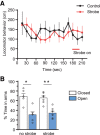Retrograde enhancement of episodic learning by a postlearning stimulus
- PMID: 33593926
- PMCID: PMC7888236
- DOI: 10.1101/lm.052191.120
Retrograde enhancement of episodic learning by a postlearning stimulus
Abstract
Evidence suggests encoding of recent episodic experiences may be enhanced by a subsequent salient event. We tested this hypothesis by giving rats a 3-min unsupervised experience with four odors and measuring retention after different delays. Animals recognized that a novel element had been introduced to the odor set at 24 but not 48 h. However, when odor sampling was followed within 5 min by salient light flashes or bedding odor, the memory lasted a full 2 d. These results describe a retroactive influence of salience to promote storage of episodic information and introduce a unique model for studying underlying plasticity mechanisms.
© 2021 Quintanilla et al.; Published by Cold Spring Harbor Laboratory Press.
Figures



References
Publication types
MeSH terms
Grants and funding
LinkOut - more resources
Full Text Sources
Other Literature Sources
